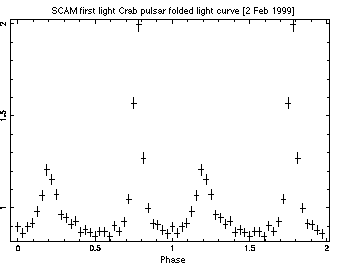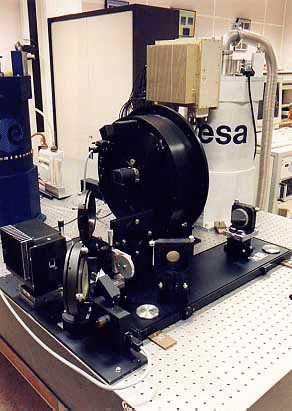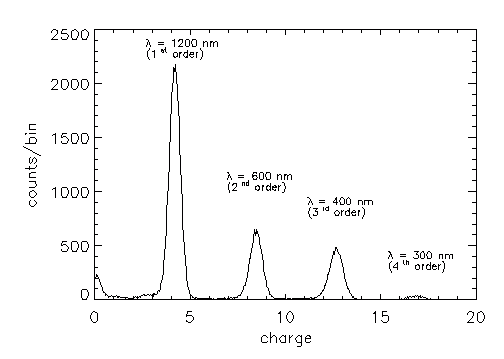| The ING Newsletter | No. 1, September 1999 |
| GENERAL | SCIENCE | OTHER NEWS FROM ING | TELESCOPE TIME |
Previous: INGRID: A New Near-IR Camera for the WHT | Up: Table of Contents | Next: Instrumentation Plans for the ING Telescopes
Super Cool Technology
Peter Moore (ING),
Nicola Rando (ESA)
Historically, technological advances have literally opened up the sky for groundbreaking discoveries in astronomy. Such examples of this are the impact of CCD technology on photon-starved spectroscopy and the extension of the observable universe through infrared detectors. We here at Isaac Newton Group are privileged to be part of just such a technological advance, which promises to allow a more complete understanding of the universe.
On the evening of February 2nd
this year, 'First Astronomical Light' was seen by a novel photon detector
device, an array of superconducting tunnel junctions. These junctions,
arranged into a small array, allowed us to measure simultaneously the time
of arrival, the energy, and the spatial distribution of photons arriving
from the Crab nebula. In contrast to current astronomical detectors,
the Superconducting Tunnel Junction (or STJ) allows these three crucial
parameters to be measured by one detection device in real time with very
good quantum efficiency across a large wavelength range. The results of
this first light technology proving run are published in Astron &
Astrophys, 346, L30 (1999). Figure 1 shows an extracted light
curve of the Crab pulsar derived from this work.
 |
| Figure 1. The Crab pulsar light curve. |
A dedicated team of scientists
and engineers at the Astrophysics Division of the European Space Agency
(ESA) have brought this technology to fruition by adapting materials and
techniques from X-ray detector technology to the visible and infrared spectrum.
The instrument built by this team to demonstrate the STJ technology is
called S-CAM (Figure 2) and combines the 6×6 pixel STJ array with
stand alone support and acquisition equipment. This instrument couples
to the Ground Based High Resolution Imaging Laboratory (or GHRIL) focal
station of the William Herschel telescope and provides a limited field
of view of 4×4 arcseconds within 36 pixels.
 |
| Figure 2. The S-CAM Instrument. |
The principle of operation for the STJ detector, electron tunnelling, is exploited by sandwiching a thin insulating layer between two superconducting layers with attached electrodes. The energy gap of the superconducting material determines the intrinsic energy resolution as well as the operating temperature of the detector. In the S-Cam case, with Ta based STJs, the intrinsic resolving power (Delta lambda FWHM) corresponds to 17 at lambda = 500 nm, at an operating temperature of about 300 mK. The actual instrument energy resolution is degraded by electrical and thermal background induced noise. By applying a small bias voltage across the junction and a suitable parallel magnetic field to suppress the Josephson current, an electrical charge proportional to the energy of the perturbing photon can be extracted from the device.
The introduction of the STJ as an astronomical detector is in many ways the natural next step beyond the CCD detector. In the latter silicon-based devices, the band gap between the ground state and the state excited by the absorption of an optical photon is comparable to the photon energy. As a consequence, only a single electron is extracted from the detector per absorbed photon irrespective of its energy. In contrast, the equivalent energy gap of superconducting niobium is some three orders of magnitude lower, which means that of the order of one thousand electrons are released per detected optical photon. More importantly the amount of charge generated is proportional to the energy of the absorbed photon. Thus by measuring the charge released by each detected photon, these can be sorted in energy to an accuracy limited by intrinsic detector resolution and by any additional electrical and thermal background induced noise. For a given junction geometry, the achievable wavelength resolution varies as (lambda3/2 )×(delta1/2 ), with delta being the superconductor energy gap. STJ based detectors have demonstrated the capability to provide spectroscopic information over a large energy range, from the NIR to the UV. By arranging a number of STJ devices into a two dimensional array, a true 'three dimensional' astronomical detector can be constructed, whose output is not just the number of photons registered in each pixel of the image, but their distribution in energy throughout the UV, visible and near-IR.
Having achieved successful first light, the team at ESA is now enhancing the S-CAM in light of the experience gained from the February run. These enhancements among other things include a slightly larger field of view (6×6 arcsec.) and increased bandwidth in the electronic processing to allow a higher dynamic range of stellar magnitudes. The awaited return of S-CAM to the WHT will take place in early December this year. It is anticipated that in parallel to the science projects to be conducted with S-CAM, development work will continue on the detector devices and their application to astronomy. In the forthcoming future this will allow a common user instrument to be offered by the ING with this unique detector technology at the WHT.
The impact that STJ detector technology will have on instrumentation for astronomy will be significant. Having the detector quantify photon energy theoretically removes the requirement for much of the optical processing of the instrument thus allowing all photons collected by the telescope to be gainfully measured, thus improving sensitivity dramatically. Time resolution photometry at different wavelengths becomes a parallel dream! Wide band imaging, from UV to IR, possible with just one detector! The potential of this technology lies in wait to reveal Nature's true colours!
Figure 3 shows the spectrum obtained
with a Ta based device by setting the monochromator at 1.2 microns and
removing the order separating filter. The spectrum spans wavelengths from
300nm in the near UV to 1.2 microns in the near-IR, and shows the simultaneous
detection of four spectral orders of the monochromator output.
 |
| Figure 3. Wide band response of STJ. |
Further information on STJ detectors and S-Cam can be found at the following URLs:
http://astro.estec.esa.nl/SA-general/Research/Stj/STJ_main.html
http://astro.estec.esa.nl/SA-general/Astronews/37-html/an37.html#stj
Email contact: Peter Moore (pcm@ing.iac.es)
Previous: INGRID: A New Near-IR Camera for the WHT | Up: Table of Contents | Next: Instrumentation Plans for the ING Telescopes
| GENERAL | SCIENCE | OTHER NEWS FROM ING | TELESCOPE TIME |